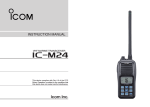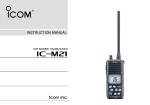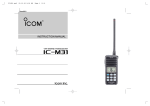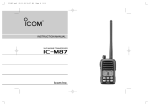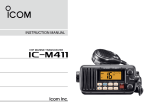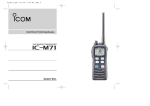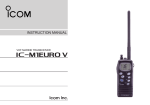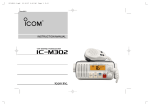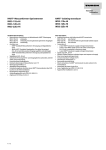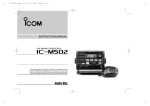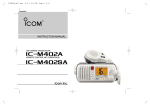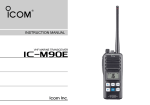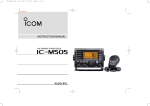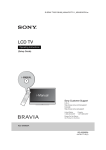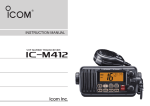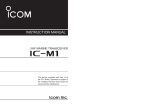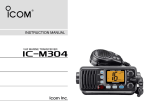Download IC-M33 Instruction Manual
Transcript
INSTRUCTION MANUAL VHF MARINE TRANSCEIVER iM33 DECLARATION OF CONFORMITY We Icom Inc. Japan 0560 1-1-32, Kamiminami, Hirano-ku Osaka 547-0003, Japan Declare on our sole responsability that this equipment complies the essential requirements of the Radio and Telecommunications Terminal Equipment Directive, 1999/5/EC, and that any applicable Essential Test Suite measurements have been performed. Kind of equipment: VHF MARINE TRANSCEIVER Type-designation: iM33 Düsseldorf 30th Nov. 2006 Place and date of issue Icom (Europe) GmbH Himmelgeister straße 100 D-40225 Düsseldorf Authorized representative name Version (where applicable): This compliance is based on conformity with the following harmonised standards, specifications or documents: i) EN 301 178-2 V1.1.1 (2000-8) ii) EN 60945 2002 iii) EN 60950-1 2001 iv) EN 300 698-2 V1.1.1 (2000-8) v) EN 300 698-3 V1.1.1 (2001-5) vi) vii) CE Versions of the IC-M33 which display the “CE” symbol on the serial number seal, comply with the essential requirements of the European Radio and Telecommunication Terminal Directive 1999/5/EC. i H. Ikegami General Manager Signature This warning symbol indicates that this equipment operates in non-harmonised frequency bands and/or may be subject to licensing conditions in the country of use. Be sure to check that you have the correct version of this radio or the correct programming of this radio, to comply with national licensing requirement. IN CASE OF EMERGENCY RECOMMENDATION If your vessel requires assistance, contact other vessels and the Coast Guard by sending a distress call on Channel 16. CLEAN THE TRANSCEIVER THOROUGHLY WITH FRESH WATER after exposure to saltwater, and dry it before operation. Otherwise, the transceiver's keys, switches and controllers may become unusable due to salt crystallization. ❍ USING CHANNEL 16 DISTRESS CALL PROCEDURE 1. “MAYDAY MAYDAY MAYDAY.” 2. “THIS IS ...........................” (name of vessel) NOTE: DO NOT wash the transceiver in water if there is any reason to suspect the waterproofing may not be effective. For example, in cases where the battery pack rubber seal is damaged, the transceiver/battery pack is cracked or broken, or has been dropped, or when the battery pack is detached from the transceiver. 3. Your call sign or other indication of the vessel. 4. “LOCATED AT .....................” (your position) 5. The nature of the distress and assistance required. 6. Any other information which might facilitate the rescue. ii FOREWORD FEATURES Thank you for purchasing this Icom radio. The IC-M33 VHF MARINE TRANSCEIVER is designed and built with Icom’s state of the art technology and craftsmanship. With proper care this radio should provide you with years of trouble-free operation. Built tough to withstand the punishing marine environment, the IC-M33’s submersible construction meets IPX7 of the corresponding International Standard IEC 60529 (2001) while using BP-251 (option) or BP-252. ☞ Floating on water IMPORTANT READ ALL INSTRUCTIONS ☞ Submersible construction carefully and com- pletely before using the transceiver. SAVE THIS INSTRUCTION MANUAL—This instruction manual contains important operating instructions for the IC-M33. The IC-M33 floats on fresh or salt water even when the supplied accessories are attached. • When third-party battery pack, strap, antenna, etc. is used, it may sink. • The battery contacts may be prone to rusting if the transceiver is kept floating in fresh or salt water. ☞ Large, easy-to-read LCD EXPLICIT DEFINITIONS WORD DEFINITION Personal injury, fire hazard or electric shock RWARNING may occur. CAUTION NOTE iii Equipment damage may occur. If disregarded, inconvenience only. No risk of personal injury, fire or electric shock. With dimensions of 16(H) × 32(W) mm, the IC-M33’s function display is easy to read and shows operating conditions at a glance. Backlighting and contrast can be adjusted to suit your preferences. ☞ Simple operation 9 large buttons on the front panel provide user-friendly operation. The independent volume and channel buttons are located on the front panel for convenient one-hand operation. PRECAUTIONS RWARNING! NEVER connect the transceiver to an AC outlet. This may pose a fire hazard or result in an electric shock. RWARNING! NEVER hold the transceiver so that the antenna is closer than 2.5 cm from exposed parts of the body, especially the face or eyes, while transmitting. The transceiver will perform best if the microphone is 5 to 10 cm away from the lips and the transceiver is vertical. NEVER connect the transceiver to a power source other than the BP-251 (option) or BP-252. Such a connection will ruin the transceiver. AVOID using or placing the transceiver in direct sunlight or in areas with temperatures below –15°C or above +55°C. BE CAREFUL! The transceiver employs waterproof construction, which corresponds to IPX7 of the international standard IEC 60529 (2001). However, once the transceiver has been dropped, waterproofing cannot be guaranteed due to the fact that the transceiver may be cracked, or the waterproof seal damaged, etc. MAKE SURE the flexible antenna and battery pack are securely attached to the transceiver, and that the antenna and battery pack are dry before attachment. Exposing the inside of the transceiver to water will result in serious damage to the transceiver. After exposure to water, clean the battery contacts thoroughly with fresh water and dry them completely to remove any water or salt residue. KEEP the transceiver out of the reach of children. KEEP the transceiver at least 0.9 meters away from your vessel’s magnetic navigation compass. BE CAREFUL! The transceiver’s right-side panel will become hot when operating continuously for long periods. Icom, Icom Inc. and the logo are registered trademarks of Icom Incorporated (Japan) in the United States, the United Kingdom, Germany, France, Spain, Russia and/or other countries. iv TABLE OF CONTENTS DOC ........................................................................................... i IN CASE OF EMERGENCY ..................................................... ii RECOMMENDATION ............................................................... ii FOREWORD ............................................................................ iii IMPORTANT ............................................................................ iii EXPLICIT DEFINITIONS .......................................................... iii FEATURES .............................................................................. iii PRECAUTIONS ....................................................................... iv TABLE OF CONTENTS ............................................................ v 1 2 3 4 v OPERATING RULES ......................................................... 1 SUPPLIED ACCESSORIES AND ATTACHMENTS ....... 2–3 ■ Supplied accessories ....................................................... 2 ■ Attachments ..................................................................... 2 PANEL DESCRIPTION .................................................. 4–7 ■ Front, top and side panels ............................................... 4 ■ Function display .............................................................. 6 BASIC OPERATION .................................................... 8–13 ■ Channel selection ........................................................... 8 ■ Receiving and transmitting ............................................ 10 ■ Call channel programming ............................................ 11 ■ Adjusting the volume level ............................................. 11 ■ Volume mute function .................................................... 11 ■ Adjusting the squelch level ........................................... 12 ■ Lock function ................................................................. 12 ■ Automatic backlighting .................................................. 12 ■ Monitor function ............................................................ 13 ■ AquaQuake water draining function .............................. 13 5 6 7 8 9 10 11 12 13 SCAN OPERATION (Except Holland version) ........ 14–15 ■ Scan types .................................................................... 14 ■ Setting TAG channels ................................................... 15 ■ Starting a scan .............................................................. 15 DUALWATCH/TRI-WATCH (Except Holland version) ... 16 ■ Description .................................................................... 16 ■ Operation ...................................................................... 16 SET MODE ................................................................. 17–20 ■ Set mode programming ................................................ 17 ■ Set mode items ............................................................. 18 BATTERY CHARGING ............................................... 21–24 ■ Battery caution .............................................................. 21 ■ Supplied battery charger ............................................... 23 ■ Optional battery case ..................................................... 23 ■ Optional battery charger ............................................... 24 OPTIONAL SPEAKER-MICROPHONE ........................... 25 ■ HM-165 descriptions ..................................................... 25 ■ Attachment .................................................................... 25 TROUBLESHOOTING ..................................................... 26 VHF MARINE CHANNEL LIST ........................................ 27 SPECIFICATIONS............................................................. 28 OPTIONS .......................................................................... 29 OPERATING RULES D Priorities • Read all rules and regulations pertaining to priorities and keep an up-to-date copy handy. Safety and distress calls take priority over all others. • You must monitor Channel 16 when you are not operating on another channel. 1 (2) OPERATOR’S LICENSE A restricted Radiotelephone Operator Permit is the license most often held by small vessel radio operators when a radio is not required for safety purposes. 1 The Restricted Radiotelephone Operator Permit must be posted near the transceiver or be kept with the operator. Only a licensed radio operator may operate a transceiver. • False or fraudulent distress calls are prohibited under law. D Privacy • Information overheard but not intended for you cannot lawfully be used in any way. • Indecent or profane language is prohibited. D Radio licenses However, non-licensed individuals may talk over a transceiver if a licensed operator starts, supervises, ends the call and makes the necessary log entries. A current copy of the applicable government rules and regulations is only required to be on hand for vessels in which a radio telephone is compulsory. However, even if you are not required to have these on hand it is your responsibility to be thoroughly acquainted with all pertinent rules and regulations. (1) SHIP STATION LICENSE When your craft is equipped with a VHF FM transceiver, you must have a current radio station license before using the transceiver. It is unlawful to operate a ship station which is not licensed. Inquire through your dealer or the appropriate government agency for a Ship-Radiotelephone license. This license includes the call sign which is your craft’s identification for radio purposes. 1 2 SUPPLIED ACCESSORIES AND ATTACHMENTS ■ Supplied accessories Handstrap Battery pack Battery charger AC adapter (with 2 screws) Antenna (Not supplied with some version) D Handstrap Pass the handstrap through the loop on the side of the transceiver as illustrated at right. This facilitates carrying. Belt clip D Belt clip Attach/detach the belt clip to the transceiver as illustrated below. ■ Attachments D Flexible antenna Connect the supplied flexible antenna to the antenna connector. CAUTION! • NEVER carry the transceiver by the antenna. • Transmitting without an antenna may damage the transceiver. 2 To attach the belt clip To detach the belt clip w Be careful! Not to break your nails. q SUPPLIED ACCESSORIES AND ATTACHMENTS 2 ï Battery pack To remove the battery pack: Turn the screw counterclockwise one quarter turn, then pull the battery pack in the direction of the arrow as shown below. NOTE: When removing or attaching the battery pack, use a coin or standard screwdriver to loosen or tighten the bottom screw. To attach the battery pack: Insert the battery pack in the IC-M33 completely, then turn the screw clockwise one quarter turn. CAUTION!: When attaching or removing a battery pack, make sure the rubber seal is set in the groove of the battery pack correctly. If the seal is not neatly in the groove it may be damaged when attaching the battery pack. If the seal is damaged, waterproofing is not guaranteed. NEVER remove or insert the battery pack when the transceiver is wet or soiled. This may result water or dust getting into the transceiver/battery pack and may result in the transceiver being damaged. 2 NOTE: When attaching a battery pack, make sure dust or other material does not adhere to the rubber seal. If dust or other material is on the seal when attaching a battery pack, water resistance may be compromised. Screw position when removing battery Screw position when attaching battery Make sure the rubber seal (purple) is properly seated in the groove and dust or other material does not adhere to it. Incorrect position Correct position Rubber seal Groove Battery pack Battery pack 3 3 PANEL DESCRIPTION ■ Front, top and side panels q w e !2 Speaker Microphone !1 !0 o Function display (pgs. 6, 7) r t y u i q POWER SWITCH [PWR] Push and hold to turn power ON and OFF. w SPEAKER-MICROPHONE CONNECTOR [SP MIC] (p. 25) Connects the optional external speaker-microphone. NOTE: Attach the [SP MIC] cap when the optional speaker-microphone is not used. Otherwise, water will get into the transceiver. q q Attach the [SP MIC] cap. w w Then rotate it clockwise completely. e ANTENNA CONNECTOR (p. 2) Connects the supplied antenna. r CHANNEL KEY [CH] ➥ Selects the regular channel when pushed. (p. 9) ➥ Selects the U.S.A.,* International or ATIS† channel group when pushed and held for 1 sec. (p. 9) ➥ Push to return to the previous channel before selecting channel 16 or the call channel. *U.K. version only; †German and Holland versions only 4 PANEL DESCRIPTION t FAVORITE/TAG KEY [FAV•TAG] ➥ While pushing and holding this key, push [Y]/[Z] to select the favorite (TAG) channels with ignoring untagged channels in the selected channel group in sequence. (p. 8) • Pushing this key only advances the displayed TAG channel. ➥ Push and hold for 1 sec. to set or clear the displayed channel as a TAG (scanned) channel. (p. 15) ➥ While pushing and holding this key, turn power ON to clear or set all TAG channels (when no TAG channel has been set) in the selected channel group. (p. 15) y SQUELCH/MONITOR KEY [SQL•MONI] ➥ Push this key, then adjust the squelch level with [Y]/[Z]. (p. 12) ➥ Manually opens the squelch for monitoring the channel while pushing and holding. (p. 13) ➥ While pushing and holding this key, turn power ON to enter the set mode. (p. 17) u TRANSMIT POWER/LOCK KEY [H/L•LOCK] ➥ Selects high or low power when pushed. (p. 10) ➥ Toggles between the key lock function ON/OFF when pushed and held for 1 sec. (p. 12) Y]/[Z Z] i CHANNEL UP/DOWN KEYS [Y ➥ Selects an operating channel. (pgs. 8, 9) ➥ Selects the set mode setting of the item. (p. 17) ➥ Checks TAG channels or changes scanning direction during scan. (p. 15) 3 o SCAN/DUAL KEY [SCAN•DUAL] ➥ Push to start or stop normal or priority scan. (p. 15) ➥ Push and hold for 1 sec. to enter watch mode. (p. 16) ➥ Push and hold this key and [H/L], to activate the AquaQuake function. (p. 13) ➥ Exits watch mode when pushed during watch operation. (p. 16) 3 !0 VOLUME KEY [VOL•MUTE] ➥ Push this key, then adjust the volume level with [Y]/[Z]. (p. 11) ➥ Push and hold for 1 sec. to activate the volume mute function. (p. 11) !1 CHANNEL 16 KEY [16•C] ➥ Push to select Channel 16. (p. 8) ➥ Push and hold for 1 sec. to select the call channel. (p. 8) ➥ Enters call channel programming condition when the call channel is selected and this key is pushed and held for 3 sec. (p. 11) ➥ Push to exit set mode during set mode operation. (p. 17) !2 PTT SWITCH [PTT] Push and hold to transmit; release to receive. (p. 10) 5 3 PANEL DESCRIPTION ■ Function display q w e r t t LOCK INDICATOR (p. 12) Appears while the lock function is activated. y u i o !8 !7 !0 !6 !1 !2 !5 !4 !3 q TRANSMIT INDICATOR (p. 10) Appears while transmitting. w BUSY INDICATOR ➥ Appears when receiving a signal or when the squelch opens. (p. 10) ➥ Blinks while monitoring. (p. 13) e TAG CHANNEL INDICATOR (p. 15) Appears when a TAG channel is selected. r CALL CHANNEL INDICATOR (p. 8) Appears when the call channel is selected. 6 y BATTERY INDICATOR Indicates remaining battery power. Indication Battery level Full Middle Charging required No battery blinks when the battery is over charged. blinks when the battery is exhausted. u SCAN INDICATOR (p. 15) Blinks while scanning. i DUALWATCH/TRI-WATCH INDICATORS (p. 16) “DUAL” appears during dualwatch; “TRI” appears during tri-watch. o DUPLEX INDICATOR Appears when a duplex channel is selected. !0 SUB CHANNEL READOUT ➥ Indicates Channel 16 during priority scan, dualwatch or tri-watch. (p. 16) ➥ Indicates the set mode item while in set mode. (p. 17) ➥ Indicates the squelch level while squelch setting. (p. 12) ➥ Indicates the volume level while volume setting. (p. 11) PANEL DESCRIPTION !1 SQUELCH LEVEL INDICATOR Shows the squelch level. 3 3 !2 VOLUME LEVEL INDICATOR ➥ Shows the volume level. ➥ Blinks when the volume mute is activated. (p. 11) !3 VOLUME LEVEL ADJUSTING INDICATOR (p. 11) Blinks while adjusting the volume level. !4 SQUELCH LEVEL ADJUSTING INDICATOR (p. 12) Blinks while adjusting the squelch level. !5 CHANNEL NUMBER READOUT ➥ Indicates the selected operating channel number. ➥ In set mode, indicates the selected condition. !6 CHANNEL GROUP INDICATOR (p. 9) U” appears when U.S.A.*; “ ” appears when Interna“U tional. *U.K. version only !7 ATIS INDICATORS (p. 9) ➥ “ATIS” appears when the channel group, which ATIS function is activated, is selected. (Available with German and Holland versions only) !8 LOW POWER INDICATOR (p. 10) ➥ “LOW” appears when low power is selected. ➥ “LOW” blinks when switching forced low power mode because of a high temperature error or low voltage. 7 4 BASIC OPERATION ■ Channel selection IMPORTANT!: Prior to using the transceiver for the first time, the battery pack must be fully charged for optimum life and operation. To avoid damage to the transceiver, turn the power OFF while charging. D Channel 16 Channel 16 is the distress and safety channel. It used for establishing initial contact with a station and for emergency communications. Channel 16 is monitored during both Dualwatch and Tri-watch. While standing by, you must monitor Channel 16. q Push [16] momentarily to select Channel 16. w Push [CH] to return to the channel used before Channel Y]/[Z Z] to select a channel. 16, or push [Y D Call channel Each regular channel group has separate leisure-use call channels. The call channel is monitored during Tri-watch. The call channels can be programmed (p. 11) and are used to store your most often used channel in each channel group for quick recall. q Push and hold [C] (16) for 1 sec. to select the call channel of the selected channel group. • “CALL” and call channel number appear. • Each channel group may have an independent call channel after programming a call channel. (p. 11) w Push [CH] to return to the channel used before call chanY]/[Z Z] to select a channel. nel, or push [Y Push and hold Push Convenient! While pushing and holding [FAV], push [Y]/[Z] to select the favorite (TAG) channels with ignoring untagged channels in the selected channel group in sequence. • Pushing [FAV] only advances the displayed TAG channel. • The favorite channels are selected using the TAG channel setting. (p. 15) 8 for 1 sec. BASIC OPERATION 4 D U.S.A., International and ATIS channels The IC-M33 is pre-programmed with U.S.A.*, International and ATIS† channels. These channel groups may be specified for the operating area. 4 *U.K. version only; German and Holland versions only † q Push [CH] to select a regular channel. w Push and hold [CH] for 1 sec. to change the channel group. Repeat to advance to the next group. • U.S.A., International and ATIS channel groups can be selected in sequence. Y]/[Z Z] to select a channel. e Push [Y • “DUP” appears for duplex channels. International channels Push and hold for 1 sec. U.S.A. channels ATIS channels 9 4 BASIC OPERATION ■ Receiving and transmitting CAUTION: Transmitting without an antenna will damage the transceiver. q Push and hold [PWR] to turn power ON. w Set the audio and squelch levels. Z] several times to open the squelch. ➥ Push [SQL], and push [Z Y]/[Z Z] to adjust the volume level. ➥ Push [VOL], then push [Y Y] until the noise disappears. ➥ Push [SQL], and push [Y IMPORTANT: To maximize the readability of your transmitted signal, pause a few sec. after pushing [PTT], hold the microphone 5 to 10 cm from your mouth and speak into the microphone at a normal voice level. NOTE: The transceiver has a power save function to conserve the battery power. The power save function activates automatically when no signal is received for 5 sec. Y]/[Z Z] to select the desired channel. e Push [Y • When receiving a signal, “ ” appears and audio is emitted from the speaker. • Further adjustment of the audio may be necessary at this point. r Push [H/L] to select the output power if necessary. • “LOW” appears when low power is selected; no indication when high power is selected. • Choose low power to conserve battery power, choose high power for longer distance communications. • Some channels are for low power only. t Push and hold [PTT] to transmit, then speak into the microphone. t Push to transmit y Release to receive Microphone 10 e Set channel w Set volume w Set the squelch level w Set the squelch and volume level. r Set output power •“ ” appears. • Channel 70 cannot be used for transmission. y Release [PTT] to receive. q Power ON BASIC OPERATION 4 ■ Call channel programming ■ Adjusting the volume level Call channel is used to access Channel 16 (default; may differ according to version), however, you can program the call chan- Y]/[Z Z]. The volume level can be adjusted with [VOL] and [Y nel with your most often-used channels in each channel group for quick recall. Y]/[Z Z]. q Push [VOL], then adjust the volume level with [Y q Push and hold [CH] for 1 sec. several times to select the desired channel group (U.S.A., International or ATIS) to be programmed. (p. 9) w Push and hold [C] (16) for 1 sec. to select the call channel of the selected channel group. • “CALL” and call channel number appear. e Push and hold [C] (16) again for 3 sec. (until a long beep changes to 2 short beeps) to begin call channel programming. • Channel number starts blinking. Y]/[Z Z] to select the desired r Push [Y channel. t Push [16] to program the displayed channel as the call channel. • The channel number stops blinking. • “VOL” indicator starts blinking. • There are 31 volume levels and OFF. • When no key is pushed for 5 sec., the transceiver returns to normal condition. 4 w Push [VOL] again to return to normal condition. Indicates the volume level. Blinks during volume level adjustment. ■ Volume mute function The volume mute function can be activated temporarily with [MUTE] (VOL). q Push and hold [MUTE] (VOL) for 1 sec to activate the volume mute function. • The audio is muted. • The volume level indicator starts blinking. w Push [VOL] again or turn power OFF to turn the volume mute function OFF. 11 4 BASIC OPERATION ■ Adjusting the squelch level ■ Lock function Y]/[Z Z] keys as To adjust the IC-M33’s squelch level, use the [Y described below. In order to receive signals properly, as well as for the scan to function effectively, the squelch must be adjusted to the proper level. This function electronically locks all keys (except for [PTT], Y]/[Z Z]*) to [SQL•MONI], [VOL•MUTE], [H/L•LOCK] and [Y prevent accidental channel changes and function access. Y]/[Z Z]. q Push [SQL], then adjust the squelch level with [Y • “SQL” indicator starts blinking. • There are 11 squelch levels to choose from: OP is completely open; 10 is tight squelch; 1 is loose squelch. • If no key is pushed for 5 sec., the transceiver returns to normal operation. w Push [SQL] again to return to normal condition. Indicates the squelch level. Blinks during squelch level adjustment. * After pushing [VOL•MUTE] or [SQL•MONI] only. ➥ Push and hold [LOCK] (H/L) for 1 sec. to turn the lock function ON and OFF. Appears while the lock function is used. Push and hold for 1 sec. ■ Automatic backlighting This function is convenient for nighttime operation. The automatic backlighting can be activated in set mode. (p. 19) ➥ Push any key except for [PTT] to turn the backlighting ON. • The backlighting is automatically turned OFF after 5 sec. of inactivity. 12 BASIC OPERATION 4 ■ Monitor function The monitor function opens the squelch. See p. 5 for details of the monitor key action. ➥ The monitor function activates while pushing and holding [MONI] (SQL). •“ 4 ” blinks and audio is emitted. Blinks while the monitor function is used. Push and hold ■ AquaQuake water draining function The IC-M33 uses a new technology to clear water away from the speaker grill: AquaQuake. AquaQuake helps drain water away from the speaker housing (water that might otherwise muffle the sound coming from the speaker). The IC-M33 emits a vibrating beep when this function is being used. ➥ Push and hold both [SCAN] and [H/L]. • A low beep tone sounds for 9 sec. to drain water, regardless of volume level setting. • The transceiver does not perform key operations while the AquaQuake function is activated. The AquaQuake function can not be activated when an optional speaker-microphone is connected. 13 5 SCAN OPERATION (Except Holland version) ■ Scan types Scanning is an efficient way to locate signals quickly over a wide frequency range. The transceiver has priority scan and normal scan. In addition, auto scan function is available for standby convenience. This function can be activated depending on the setting in set mode. (p. 18) PRIORITY SCAN CH 01 CH 02 CH 16 CH 05 CH 03 CH 04 Priority scan searches through all TAG channels in sequence while monitoring Channel 16. When a signal is detected on Channel 16, scan pauses until the signal disappears; when a signal is detected on a channel other than Channel 16, scan becomes dualwatch until the signal disappears. 14 Choose priority or normal scan in set mode. (p. 18) NORMAL SCAN CH 01 CH 88 Set the TAG channels (scanned channels) before scanning. Clear any TAG channels which inconveniently stop scanning, such as digital communications. CH 02 CH 88 CH 03 CH 05 CH 04 Normal scan, like priority scan, searches through all TAG channels in sequence. However, unlike priority scan, Channel 16 is not checked unless Channel 16 is set as a TAG channel. SCAN OPERATION 5 ■ Setting TAG channels ■ Starting a scan For more efficient scanning, set the desired channels as TAG channels or clear the TAG setting from unwanted channels. Channels that are not tagged will be skipped during scanning. TAG channels can be assigned to each channel group (U.S.A., International and ATIS) independently. Set the priority scan function, scan resume timer and auto scan function in advance, using set mode. (p. 18) q Push and hold [CH] for 1 sec. several times to select the desired channel group, if desired. w Select the desired channel to be set as a TAG channel. e Push and hold [TAG] (FAV) for 1 sec. to set the displayed channel as a TAG channel. •“ ” appears in the function display. r To cancel the TAG channel setting, push and hold [TAG] (FAV) for 1 sec. •“ ” disappears. • “SCAN” blinks in the function display. • “16” appears on the sub channel readout during priority scan. • When a signal is received, scan pauses until the signal disappears or resumes after pausing 5 sec. according to the scan resume timer setting. (Channel 16 is still monitored during priority scan.) • Push [Y]/[Z] to check which channels have been set as TAG channels, change the scanning direction or resume the scan manually. ✔ Clearing (or setting) all tagged channels While pushing and holding [TAG] (FAV), turn power ON to clear all TAG channels in the selected channel group. q Push and hold [CH] for 1 sec. several times to select the desired channel group, if desired. w Push [SCAN] to start priority or normal scan. 5 e To stop the scan, push [SCAN]. • “SCAN” disappears. • Pushing [PTT], [16], [CH] or [FAV] also stops the scan. • Repeat above procedure to set all channels as TAG channels (when no TAG channel has been set.) [Example]: Starting a normal scan. Scan starts When a signal is received Push Push to stop the scan 15 6 DUALWATCH/TRI-WATCH (Except Holland version) ■ Description ■ Operation Dualwatch monitors Channel 16 while you are receiving on another channel; Tri-watch monitors Channel 16 and the call channel while receiving another channel. Dualwatch/Triwatch is convenient for monitoring Channel 16 when you are operating on another channel. q Select Dualwatch or Tri-watch in set mode. (p. 19) w Select the desired channel. e Push and hold [DUAL] (SCAN) for 1 sec. to start Dualwatch or Tri-watch (depending on set mode setting). DUALWATCH/TRI-WATCH SIMULATION Call channel • “DUAL” blinks during dualwatch; “TRI” blinks during tri-watch. • A beep tone sounds when a signal is received on Channel 16. • Tri-watch becomes dualwatch when receiving a signal on the call channel. r To cancel dualwatch/tri-watch, push [SCAN] again. [Example]: Operating Tri-watch on INT channel 07. Dualwatch Signal is received on call channel. Tri-watch resumes after the signal disappears. Signal received on Channel 16 takes priority. Tri-watch • If a signal is received on Channel 16, dualwatch/tri-watch pauses on Channel 16 until the signal disappears. • If a signal is received on the call channel during Tri-watch, Tri-watch becomes Dualwatch until the signal disappears. • To transmit on the selected channel during Dualwatch/Triwatch, push and hold [PTT]. 16 Tri-watch starts. SET MODE 7 ■ Set mode programming D Set mode operation Set mode is used to change the settings for 11 transceiver functions: beep tone function, priority scan function, scan resume timer, auto scan function, dual/tri-watch function, monitor key action, automatic backlighting, LCD contrast setting, power save function, squelch sensitivity and low fix function*. q Turn power OFF. w While pushing [SQL], turn power ON to enter set mode. • “bP” appears. Y]/[Z Z] while pushing and holding [SQL] e Push [SQL] or [Y to select the desired item, if necessary. Y]/[Z Z] to select the desired setting of the item. r Push [Y t To exit set mode, push [16]. *Appears only when the optional battery case is attached; Not available with German version. D SET MODE ITEMS • Low fix* 6 7 (The display shows the current settings, and the selected function is displayed in the dotted circle.) • Priority scan† • Beep tone • Scan resume timer† Starting item • Auto scan† • Squelch sensitivity : Push : Push • Power save • LCD contrast or + [Y] + [Z] • Automatic backlighting *Appears only when the optional battery case is attached; Not available with German version. † Not available with Holland version. • Monitor key action • Dual/Tri-watch† 17 7 SET MODE ■ Set mode items D Beep tone function “bP” Select the key touch beep sound from ON or US, or turn sound OFF. • US : The preset beeps (e.g. do, re, mi) sound • ON : A fixed beep sounds (default) • OFF: Silent operation D Scan resume timer “St” (Not available with Holland version) The scan resume timer can be set as a pause (OFF) or timer scan (ON). When OFF is selected, the scan pauses until a received signal disappears. When ON is selected, the scan pauses for 5 sec. after receiving a signal and then resumes even if the signal is being received. Push Push Beep tone ON (default) Beep tone OFF D Priority scan function “Pr” Scan resume timer OFF (default) Scan resume timer ON (Not available with Holland version) The transceiver has 2 scan types— normal (OFF) and priority (ON) scans. Normal scan searches all TAG channels in the selected channel group. Priority scan searches all TAG channels in sequence while monitoring Channel 16. D Auto scan function “AS” (Not available with Holland version) The auto scan function starts the desired scan automatically when no signal is received, and no operation is performed for 30 sec. Push Push Normal scan Priority scan (default) Auto scan OFF (default) 18 Auto scan ON 7 SET MODE D Dual/Tri-watch function “dt” (Not available with Holland version) This item selects dual or tri-watch as desired. See p. 16 for details. D Automatic Backlighting “bL” This function is convenient for nighttime operation. The backlight can be selected from ON and OFF. • The backlight is automatically activated when any key except for [PTT] is pushed. • The backlight is automatically turned OFF after 5 sec. of inactivity. Push Dualwatch function (default) D Monitor key action “Sq” The monitor key opens the squelch temporarily. This key action contains PUSH (Pu) or HOLD (Ho) settings as shown below. • Pu (PUSH): After pushing [MONI] (SQL) for 1 sec., the squelch opens and emits audio. The squelch is held open while continuously pushing and holding [MONI] (SQL). (default) • Ho (HOLD): After pushing [MONI] (SQL) for 1 sec., the squelch opens and emits audio even while [MONI] (SQL) is released. To close the squelch, push any key. 7 Push Tri-watch function Auto backlighting ON (default) Auto backlighting OFF D LCD contrast setting “LC” Set the LCD contrast level from High contrast or Low contrast. NOTE: The LCD contrast level between High contrast and Low contrast makes no difference indoors. Push Push Push setting (default) High contrast (default) Low contrast Hold setting 19 7 SET MODE D Power save function “PS” D Low fix function “LF” The power save function reduces current drain by deactivating the receiver circuit for preset intervals. (Appears only when the optional battery case is attached. Not available with German version.) • ON When this function is turned ON, the output power is fixed to low except for channel 16. : The power save function is turned ON. The power save function will activate when no signal is received, and no operation is performed for 5 sec. • OFF : The power save function is turned OFF. Push Push Power save ON (default) Low fix function OFF (default) Power save OFF D Squelch sensitivity “SS” When this function is turned ON, rejection of noise is improved so that the squelch is not easily affected by noise. Push Squelch sensitivity OFF (default) 20 Squelch sensitivity ON Low fix function ON BATTERY CHARGING 8 ■ Battery caution Misuse of Lithium-Ion batteries may result in the following hazards: smoke, fire, or the battery may rupture. Misuse can also cause damage to the battery or degradation of battery performance. R DANGER! Use and charge only specified Icom battery pack with Icom radios or Icom charger. Only Icom battery pack is tested and approved for use and charge with Icom radios or Icom charger. Using third-party or counterfeit battery packs or charger may cause smoke, fire, or cause the battery to burst. D Battery caution R DANGER! DO NOT hammer or otherwise impact the battery. Do not use the battery if it has been severely impacted or dropped, or if the battery has been subjected to heavy pressure. Battery damage may not be visible on the outside of the case. Even if the surface of the battery does not show cracks or any other damage, the cells inside the battery may rupture or catch fire. R DANGER! NEVER use or leave battery pack in areas with temperatures above +60˚C. High temperature buildup in the battery, such as could occur near fires or stoves, inside a sunheated car, or by setting the battery in direct sunlight may cause the battery to rupture or catch fire. Excessive temperatures may also degrade battery performance or shorten battery life. R DANGER! DO NOT expose the battery to rain, snow, seawater, or any other liquids. Do not charge or use a wet battery. If the battery gets wet, be sure to wipe it dry before using. The battery by itself is not waterproof. R DANGER! NEVER incinerate a used battery pack since internal battery gas may cause them to rupture or may cause an explosion. R DANGER! NEVER solder the battery terminals, or NEVER modify the battery pack. This may cause heat generation, and the battery may rupture, emit smoke or catch fire. R DANGER! Use the battery only with the transceiver for which it is specified. Never use a battery with any other equipment, or for any purpose that is not specified in this instruction manual. 1 2 3 4 5 6 7 8 9 10 11 12 13 14 15 16 R DANGER! If fluid from inside the battery gets in your eyes, blindness can result. Rinse your eyes with clean water, without rubbing them, and see a doctor immediately. 21 8 BATTERY CHARGING WARNING! Immediately stop using the battery if it emits an abnormal odor, heats up, or is discolored or deformed. If any of these conditions occur, contact your Icom dealer or distributor. WARNING! Immediately wash, using clean water, any part of the body that comes into contact with fluid from inside the battery. WARNING! NEVER put the battery in a microwave oven, high-pressure container, or in an induction heating cooker. This could cause overheating, a fire, or cause the battery to rupture. CAUTION! Always use the battery within the specified temperature range for the transceiver (–15˚C to +55˚C) and the battery itself (–20˚C to +60˚C). Using the battery out of its specified temperature range will reduce the battery’s performance and battery life. CAUTION! Shorter battery life could occur if the battery is left fully charged, completely discharged, or in an excessive temperature environment (above +50˚C) for an extended period of time. If the battery must be left unused for a long time, it must be detached from the radio after discharging. You may use the battery until the battery indicator shows half-capacity ( ), then keep it safely in a cool dry place with the temperature between –20˚C to +20˚C. 22 D Charging caution R DANGER! NEVER charge the battery pack in areas with extremely high temperatures, such as near fires or stoves, inside a sun-heated car, or in direct sunlight. In such environments, the safety/protection circuit in the battery will activate, causing the battery to stop charging. WARNING! DO NOT charge or leave the battery in the battery charger beyond the specified time for charging. If the battery is not completely charged by the specified time, stop charging and remove the battery from the battery charger. Continuing to charge the battery beyond the specified time limit may cause a fire, overheating, or the battery may rupture. WARNING! NEVER insert the battery and transceiver (battery attached to the transceiver) into the charger if it is wet or soiled. This could corrode the battery charger terminals or damage the charger. The charger is not waterproof. CAUTION! DO NOT charge the battery outside of the specified temperature range: ±0˚C to +40˚C. Icom recommends charging the battery at +20˚C. The battery may heat up or rupture if charged out of the specified temperature range. Additionally, battery performance or battery life may be reduced. BATTERY CHARGING 8 ■ Supplied battery charger ■ Optional battery case ï Charging connections When you would like to use the optional AAA(LR03) size battery case (BP-251), install the batteries as illustrated below. Be sure to observe the correct polarity. Do not charge batteries other than the BP-252. q Attach the BC-173 to a flat surface, such as a desk, if desired. w Connect the AC adapter as shown below. e Insert the battery pack with/without the transceiver into the charger. • The charge indicator lights orange. • The charge indicator blinks orange (or orange/green alternately) when the protector is activated. r Charge the battery pack approx. 10 hours, depending on the remaining battery charge. • The charge indicator lights green when charging is completed. Charge indicator lights orange when the battery pack (with/without the transceiver) is inserted. Battery pack Transceiver Turn power OFF NOTE: The battery charger, BC-173, has a charging timer. The timer stops the charging process after 14 hours (approx.). CAUTION: • When installing batteries, make sure they are all the same brand, type and capacity. Also, do not mix new and old batteries together. • Keep battery contacts clean. It’s a good idea to clean battery terminals once a week. • When using the optional battery case, output power level is 2 W (at high; except German version). NOTE: The transceiver may sink when the optional battery case is attached. (Depends on the weight of the installed batteries.) 1 2 3 4 5 6 7 8 9 10 11 12 13 14 15 16 BC-173 AC adapter Supplied screws 23 8 BATTERY CHARGING ■ Optional battery charger D BC-162 installation • To a desktop Supplied screws D Charging • To a wall Supplied screws q Connect the AC adapter as shown below. w Insert the battery pack with/without the transceiver into the charger. • The charge indicator lights orange. • The charge indicator blinks orange (or red) when the protector is activated. e Charge the battery pack approx. 2 hours, depending on the remaining battery charge. • The charge indicator lights green when charging is completed. NOTE: The battery charger, BC-162, has a charging timer. The timer stops the charging process after 4 hours (approx.). Battery pack Transceiver • For added stability Turn power OFF Eyelet: Use a rubber band to secure the transceiver, if desired. Charge indicator BC-162 AC adapter (Optional for some versions) 24 OPTIONAL SPEAKER-MICROPHONE ■ HM-165 descriptions Alligator type clip To attach the speaker-mic. to your shirt or collar, etc. PTT switch Transmits during push. Receives during release. Microphone Speaker Turn the transceiver power OFF when connecting the HM-165. NEVER immerse the connector in water. If the connector becomes wet, be sure to dry it BEFORE attaching it to the transceiver. NOTE: The microphone is located at the top of the speaker-microphone, as shown in the diagram above. To maximize the readability of your transmitted signal (voice), hold the microphone approx. 2.5 cm from your mouth, and speak in a normal voice level. 9 ■ Attachment Turn power OFF before attaching the speaker-microphone. Then, insert the speaker-mic connector onto the [SP MIC] connector and carefully screw it tight, as shown in the diagram below. Be careful not to cross-thread the connection. IMPORTANT: KEEP the transceiver’s [SP MIC] connector cap attached when the speaker-microphone is not in use. If the cover is not attached, water will get into the transceiver. Moreover, the terminals (pins) will become rusty, or the transceiver will function abnormally if the connector has become wet. CAUTION: Attach the speaker-microphone’s connector securely to prevent accidental loss, or water intrusion in the connector. Detaching: Rotate the [SP MIC] cap counterclockwise (q), then detach it (w). w q Attaching: Attach the [SP MIC] cap (q), then rotate it clockwise completely (w). q 1 2 3 4 5 6 7 8 9 10 11 12 13 14 15 16 w 25 10 TROUBLESHOOTING PROBLEM POSSIBLE CAUSE SOLUTION p. 23 p. 3 No sound from speaker. • Squelch level is too high. • Volume level is too low. p. 12 p. 11 • Speaker has been exposed to water. • Set squelch to the threshold point. Y]/[Z Z] after pushing [VOL] to set a • Push [Y suitable level. • Drain water from the speaker. Transmitting is impossi- • Some channels are for low power or re- • Change channels. ble, or high power can ceive only. • Recharge the battery pack. • The battery is exhausted. not be selected. • Verify the battery voltage is correct. • The battery over charged. • Push [H/L] to select high power. • The output power is set to low. 26 REF. The transceiver does • The battery is exhausted. • Recharge the battery pack. not turn ON. • The battery pack is not attached correctly. • Attach the battery pack correctly. p. 13 pgs. 8, 9, 27 p. 23 — p. 10 The displayed channel • Lock function is activated. cannot be changed. • Push and hold [LOCK] (H/L) for 1 sec. to p. 12 cancel the function. Scan does not start. • “TAG” channels are not programmed. • Set the desired channels as “TAG” channels. p. 15 No beeps. • Beep tone function is turned OFF. • Set the beep tone to ON (Fix Beep/User p. 18 Beep) in set mode. Battery voltage error • The connected battery pack’s voltage is • Verify the battery voltage is correct. more than 11 V. — VHF MARINE CHANNEL LIST 11 • International channels CH 01 02 03 04 05 06 07 08 09 10 Frequency (MHz) CH Transmit Receive 156.050 156.100 156.150 156.200 156.250 156.300 156.350 156.400 156.450 156.500 160.650 11 160.700 12 160.750 13 160.800 14 160.850 15*1 156.300 16 160.950 17*1 156.400 18 156.450 19 156.500 20 Frequency (MHz) Transmit Receive 156.550 156.600 156.650 156.700 156.750 156.800 156.850 156.900 156.950 157.000 156.550 156.600 156.650 156.700 156.750 156.800 156.850 161.500 161.550 161.600 CH 21 22 23 24 25 26 27 28 60 61 Frequency (MHz) Transmit Receive 157.050 157.100 157.150 157.200 157.250 157.300 157.350 157.400 156.025 156.075 161.650 161.700 161.750 161.800 161.850 161.900 161.950 162.000 160.625 160.675 CH 62 63 64 65 66 67 68 69 70 71 Frequency (MHz) Transmit 156.125 156.175 156.225 156.275 156.325 156.375 156.425 156.475 Rx only 156.575 CH Receive 160.725 72 160.775 73 160.825 74 160.875 75*2 160.925 76*2 156.375 77 156.425 78 156.475 79 156.525 80 156.575 81 Frequency (MHz) Transmit Receive 156.625 156.675 156.725 156.775 156.825 156.875 156.925 156.975 157.025 157.075 156.625 156.675 156.725 156.775 156.825 156.875 161.525 161.575 161.625 161.675 CH 82 83 84 85 86 87 88 Frequency (MHz) Transmit Receive 157.125 157.175 157.225 157.275 157.325 157.375 157.425 161.725 161.775 161.825 161.875 161.925 157.375 157.425 *1 Channels 15 and 17 may also be used for on-board communications provided the effective radiated power does not exceed 1 W, and subject to the national regulations of the administration concerned when these channels are used in its territorial waters. *2 The use of these channels should be restricted to navigation-related communications only and all precautions should be taken to avoid harmful interference to channel 16, e.g. by limiting the output power to 1 W or by means geographical separation. • USA channels (for U.K. versions only) CH 01A –– 03A –– 05A 06 07A 08 09 10 11 Frequency (MHz) Transmit Receive 156.050 ––– 156.150 ––– 156.250 156.300 156.350 156.400 156.450 156.500 156.550 156.050 ––– 156.150 ––– 156.250 156.300 156.350 156.400 156.450 156.500 156.550 CH 12 13 14 15 16 17 18A 19A 20 20A 21A Frequency (MHz) Transmit Receive 156.600 156.650 156.700 156.750 156.800 156.850 156.900 156.950 157.000 157.000 157.050 156.600 156.650 156.700 156.750 156.800 156.850 156.900 156.950 161.600 157.000 157.050 CH 22A 23A 24 25 26 27 28 37A* 61A –– 63A Frequency (MHz) CH Frequency (MHz) Transmit Receive Transmit Receive 157.100 157.150 157.200 157.250 157.300 157.350 157.400 157.850 156.075 ––– 156.175 157.100 64A 156.225 157.150 65A 156.275 161.800 66A 156.325 161.850 67 156.375 161.900 68 156.425 161.950 69 156.475 162.000 70 Rx only 157.850 71 156.575 156.075 72 156.625 73 156.675 ––– 156.175 74 156.725 156.225 156.275 156.325 156.375 156.425 156.475 156.525 156.575 156.625 156.675 156.725 CH 77 78A 79A 80A 81A 82A 83A 84 84A 85 85A Frequency (MHz) CH Frequency (MHz) Transmit Receive Transmit Receive 156.875 156.925 156.975 157.025 157.075 157.125 157.175 157.225 157.225 157.275 157.275 156.875 86 157.325 156.925 86A 157.325 156.975 87 157.375 157.025 87A 157.375 157.075 88 157.425 157.125 88A 157.425 157.175 P4* 161.425 161.825 157.225 161.875 157.275 161.925 157.325 161.975 157.375 162.025 157.425 161.425 1 2 3 4 5 6 7 8 9 10 11 12 13 14 15 16 *UK marina channels: M1=37A (Tx/Rx: 157.850 MHz), M2=P4 (Tx/Rx: 161.425 MHz) for U.K. versions only. 27 12 SPECIFICATIONS ï GENERAL • Frequency coverage • Mode • Channel spacing • Power supply requirement • Current drain (at 7.4 V DC) • Frequency stability • Useable temperature range • Dimensions (Projections not included) • Weight ï RECEIVER : Transmit 156.000–161.450 MHz Receive 156.000–163.425 MHz : FM (16K0G3E) : 25 kHz : BP-251 and BP-252 only : TX High (5 W) 1.5 A TX Low (1 W) 0.7 A Max. audio 0.2 A Power save 20 mA typical : ±1.5 kHz : –15°C to +55°C : 62 (W) × 141.5(H) × 43(D) mm : Approx. 305 g (incl. BP-252, FA-SC58V and MB-109) ï TRANSMITTER • Output power (at 7.4 V DC) : 5 W (High)* and 1 W (Low)* *1 W (High) and 0.5 W (Low) only for German version. • Modulation system • Max. frequency deviation • Adjacent channel power • Spurious emissions 28 : Variable reactance frequency modulation : ±5 kHz : 70 dB : 0.25 µW • Receive system : Double-conversion superheterodyne • Sensitivity (20 dB SINAD) : –2 dBµ emf typical • Squelch sensitivity : –6 dBµ emf typical (at threshold) • Intermodulation rejection ratio : 68 dB • Spurious response rejection ratio : 70 dB • Adjacent channel selectivity : 70 dB • Audio output power : 0.2 W at 10% distortion with an 8 Ω load All stated specifications are subject to change without notice or obligation. OPTIONS D BATTERY CASE AND PACK • BP-251 BATTERY CASE Battery case for 5 × AAA (LR03) alkaline cells. Output power level: 2 W (except for German version) • BP-252 Li-Ion BATTERY PACK 7.4 V/980 mAh Li-Ion battery pack. D CHARGERS • BC-173 DESKTOP CHARGER + BC-174E/BM-95V AC ADAPTER Used for regular charging of battery pack. An AC adapter is supplied with the charger depending on versions. Charging time: approx. 10 hours • BC-162 DESKTOP CHARGER + BC-145* AC ADAPTER Used for rapid charging of battery pack. Charging time: approx. 2 hours. *Not supplied with some versions. D BELT CLIPS • MB-109 BELT CLIP The same as supplied with the transceiver. D OTHER OPTIONS • HM-165 SPEAKER-MICROPHONE Full sized waterproof (IPX7; 1m/30 min.) speaker-microphone. Includes an alligator clip to attach the speaker mic to your shirt, collar, etc. • FA-SC58V ANTENNA FOR IC-M33 13 1 2 3 4 5 6 7 8 9 10 11 12 13 14 15 16 29 <Intended Country of Use> ■ GER ■ FRA ■ ESP ■ SWE ■ AUT ■ NED ■ POR ■ DEN ■ GBR ■ BEL ■ ITA ■ FIN ■ IRL ■ LUX ■ GRE ■ SUI ■ NOR A-6545H-1EU Printed in Japan © 2007 Icom Inc. Printed on recycled paper with soy ink. 1-1-32 Kamiminami, Hirano-ku, Osaka 547-0003, Japan






































